For many of us, while Facebook, Instagram, and Twitter are likely all downloaded on our phones, TikTok is front and center on the homepage. The video-sharing platform has taken the world by storm, and users simply can’t get enough of this content on social media.
The app’s lightning-quick rise to fame has us asking the question: What’s so special about it? To find out, we analyzed hundreds of popular TikTok videos by watching the first three seconds of each and recording tons of information about their “hooks.” Using this data, including specifics about content captioning and engagement numbers, we might have the beginnings of an answer to this question.
Key Findings
- Happiness was the most common emotion triggered by viral TikTok videos: 58% were made in a way that inspired happiness over other emotions.
- More than 1 in 3 viral TikTok videos focused on a person speaking within the first three seconds.
- Some genres of TikTok videos were much more likely than others to come from verified accounts, namely life hacks, advice, and wellness along with fitness and sports.
- Popular dance videos received more plays, on average, than videos in any of the other top five genres. However, they were also among the least shared and commented on.
- More than half of viral TikTok videos used music as their primary backing sound in the first three seconds.
It’s a Happy Place
TikTok is a personal and emotional place — let’s see what kind of feelings viral videos evoke in people.

Of the viral TikTok videos we analyzed, a significant chunk focused on a person speaking directly to the camera. Many content creators try to broaden their horizons and develop more personal relationships with their viewers, which might explain why so many clips revolve around a face-to-face interaction
Here are some other interesting findings that relate to this area of investigation:
- Sixty percent of viral videos featured one person visible on screen. Only about 17% had no humans visible, and less than 10% featured more than two.
- One in 4 viral videos featured at least one animal.
- Dogs were more popular than cats: 46% of viral animal videos showed dogs, while only 28% featured cats.
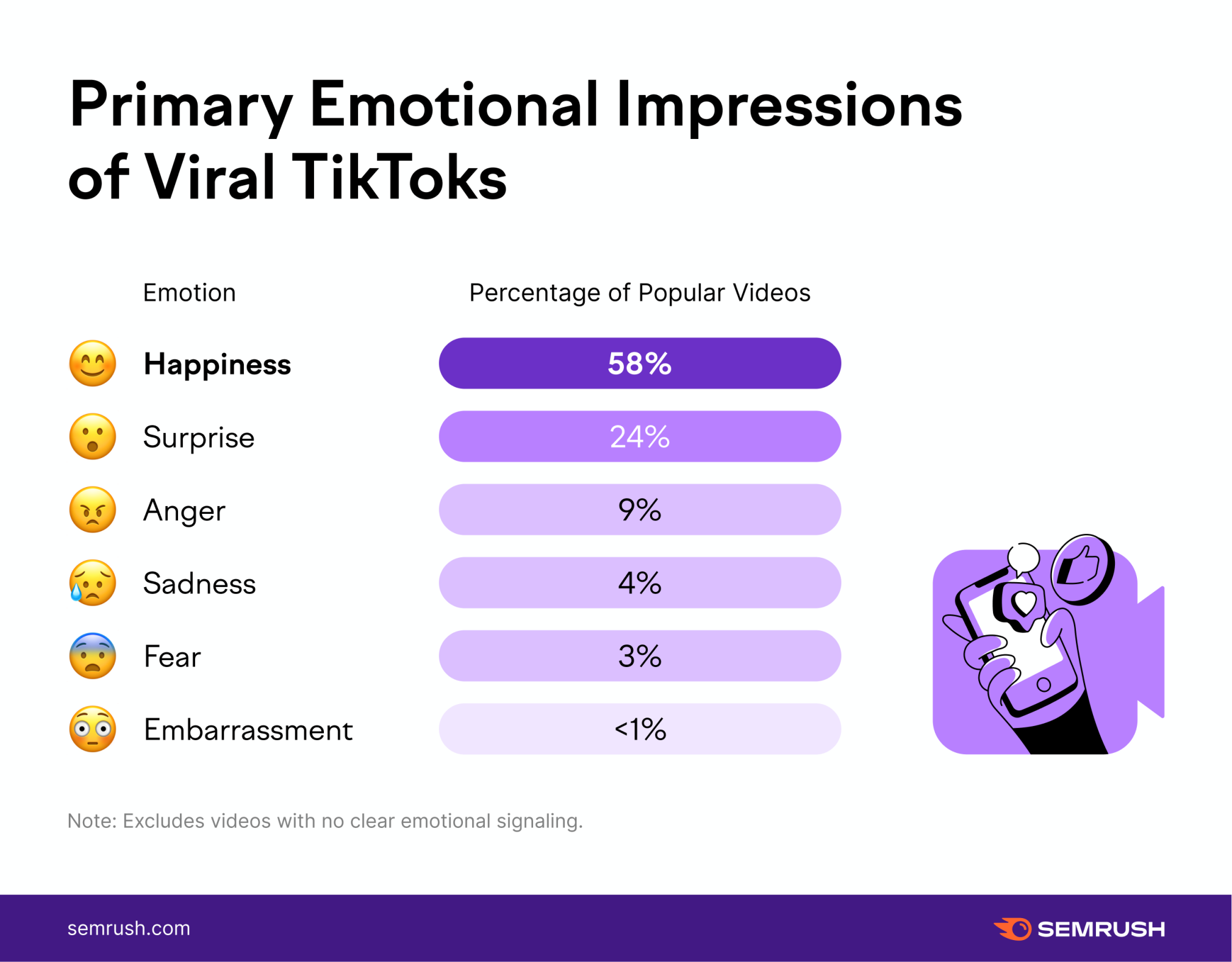
There’s a reason why the app has recently hit one billion monthly users, and it might have something to do with the fact that happiness, humor, and surprise were by far the most common emotions sparked by the videos we analyzed. This sort of delightful content is a key part of the technological strategy that makes TikTok so addictive: we see something delightful, it triggers a dopamine response.
E for Everyone
Popular social media platforms have the ability to quickly skyrocket someone to stardom. Many times, people are caught by surprise when this happens. On TikTok, 83% of viral videos we analyzed came from non-verified accounts. Gaining notoriety, exposure, and fame can clearly happen to anyone, making the app the place to be for both casual users as well as aspiring influencers.
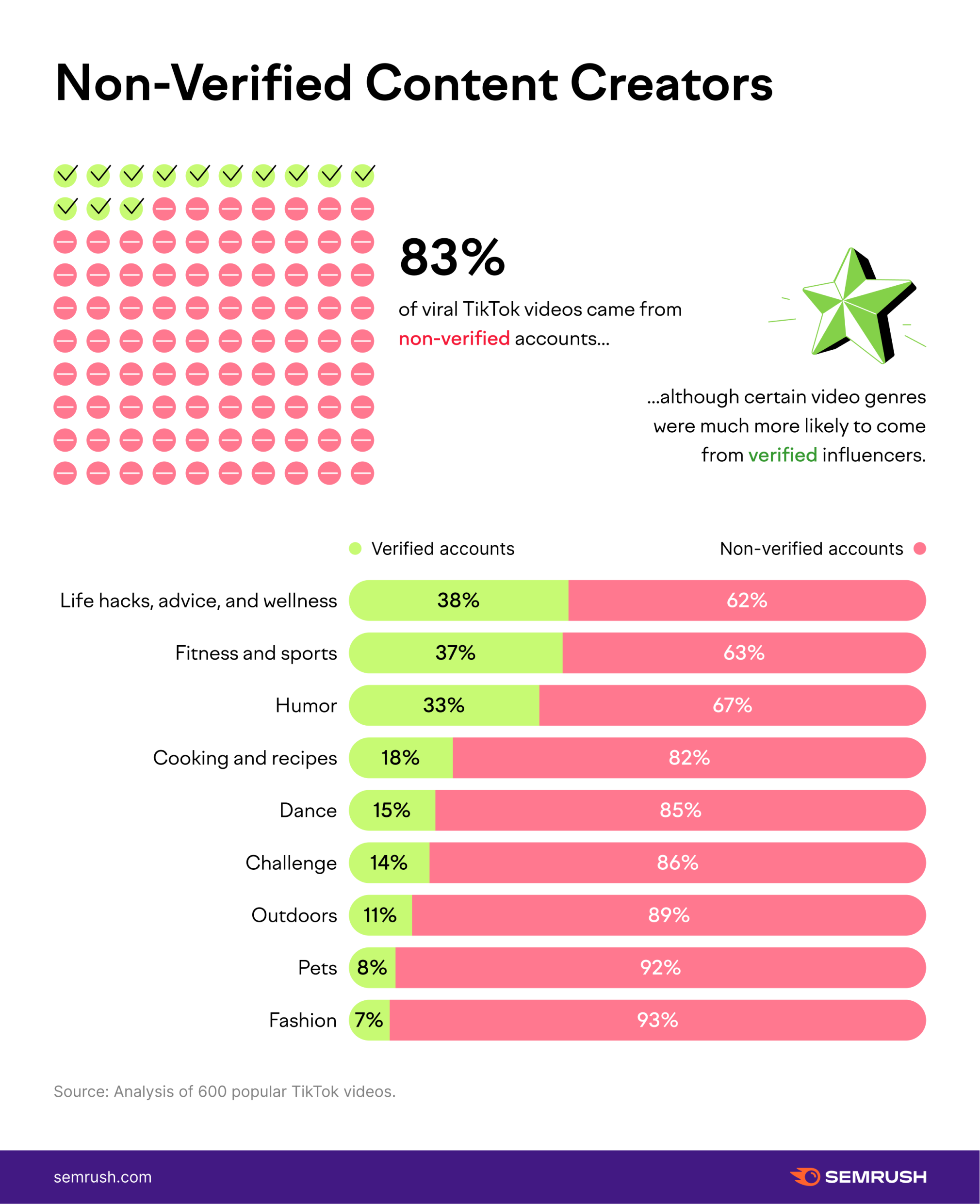
Some genres of videos are more likely than others to stem from verified accounts. 38% of viral videos in the life hacks, advice, and wellness and fitness and sports categories stemmed from verified users. For example, Demi Bagby, a CrossFit athlete and one of the top female TikTok influencers, had well over 14 million followers and 285 million likes on her page at the time of writing. Someone with that large a following is bound to produce a healthy amount of viral content. These high-profile accounts also see boosts to engagement, benefiting from higher median likes, views, comments, and shares.
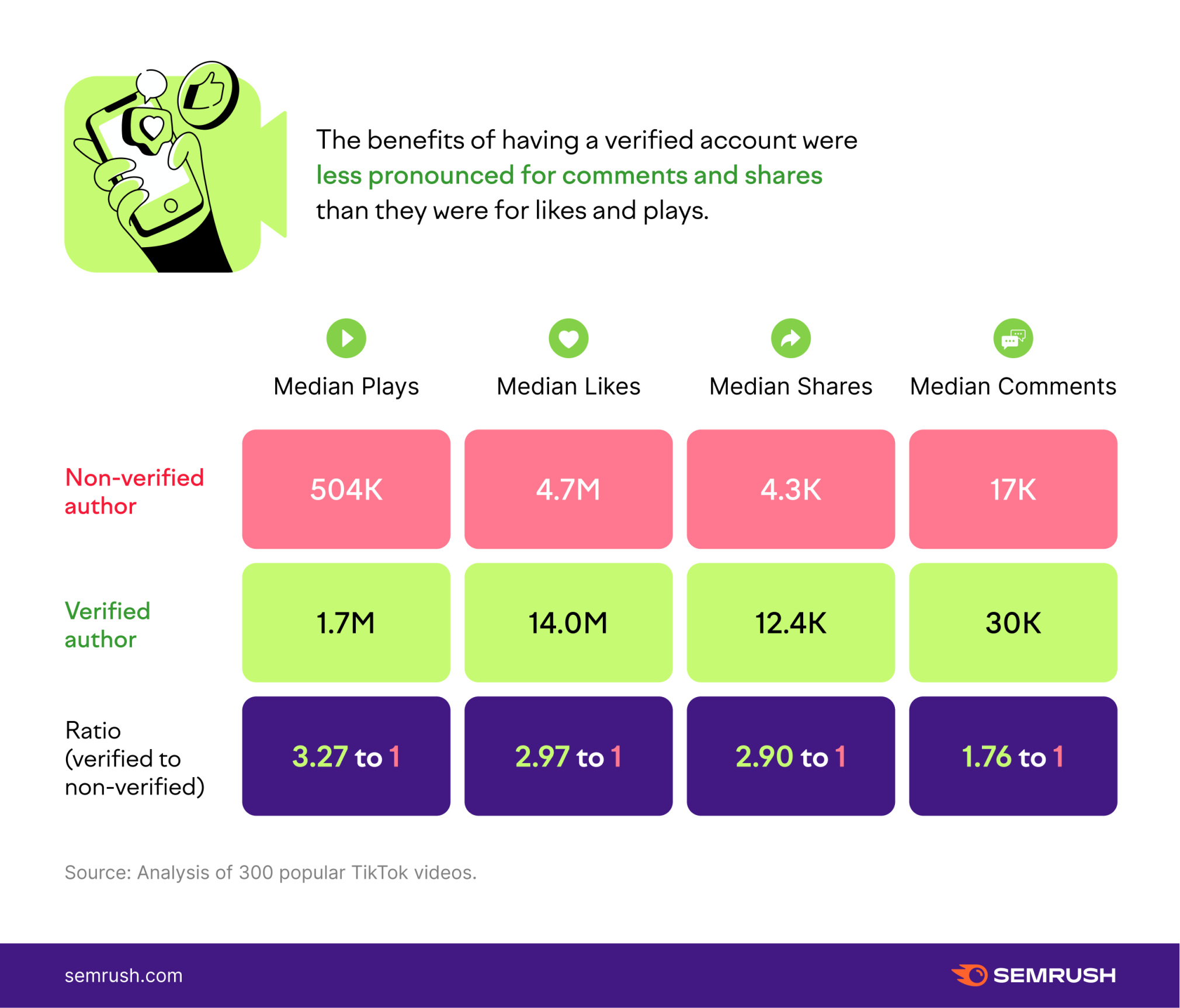
Different Strokes for Different Folks
People’s feeds are curated based on their video preferences. What kind of viral videos do people watch, like, share, and comment on the most?
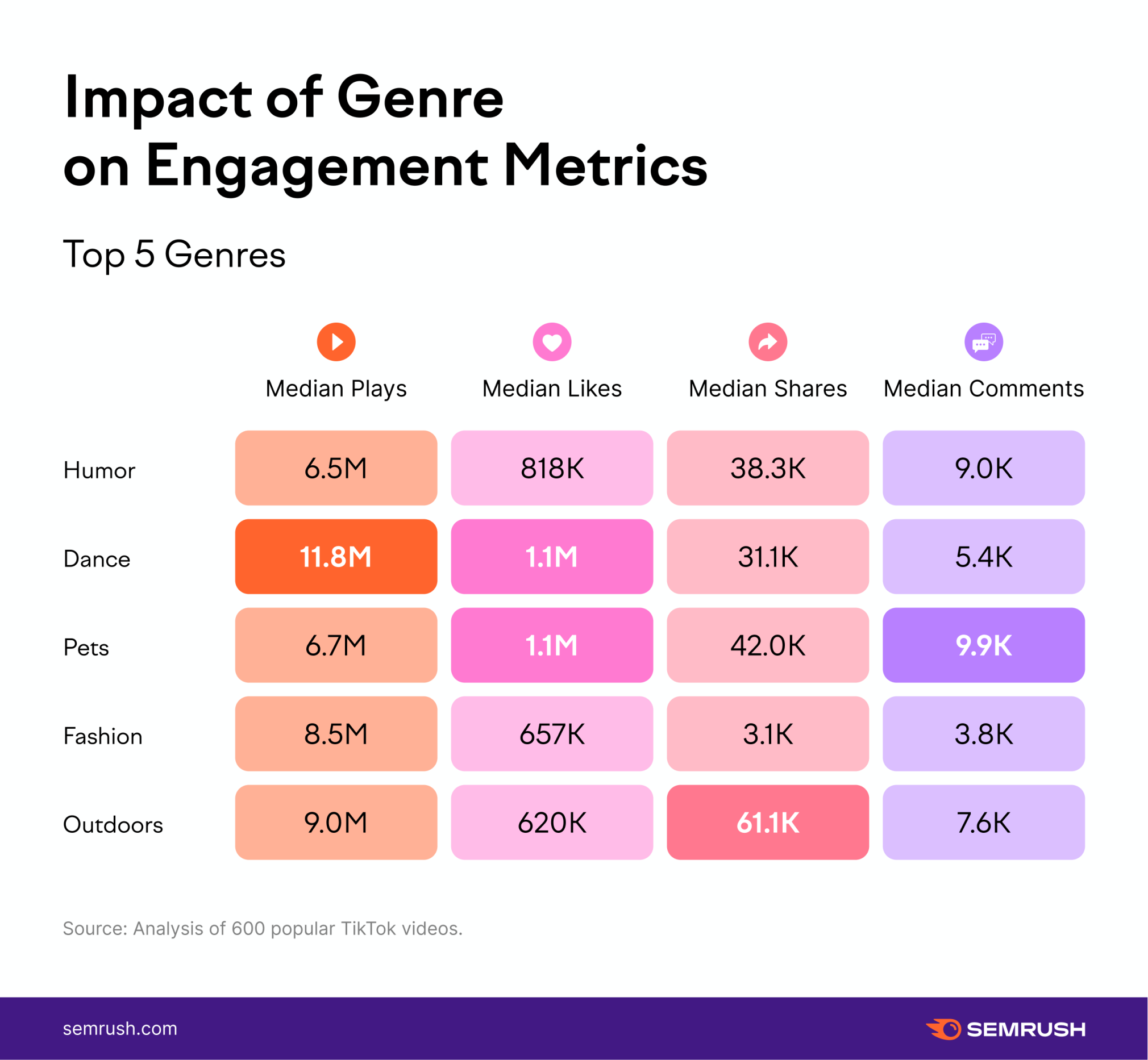
- Viral dance videos had almost 3 million more median plays than the next most popular genre, the outdoors (which was also the most shared genre). Charli D’Amelio and Addison Rae, who both started their TikTok careers with an emphasis on dance videos, are currently the first and third-most followed influencers on the app, respectively.
- Regarding median likes, people also highly approved of dance videos, as they tied with pet videos with 1.1 million each.
- People also couldn’t help themselves from commenting on cute animals, as these TikTok videos had a median of 9,900 comments — the highest of any genre.
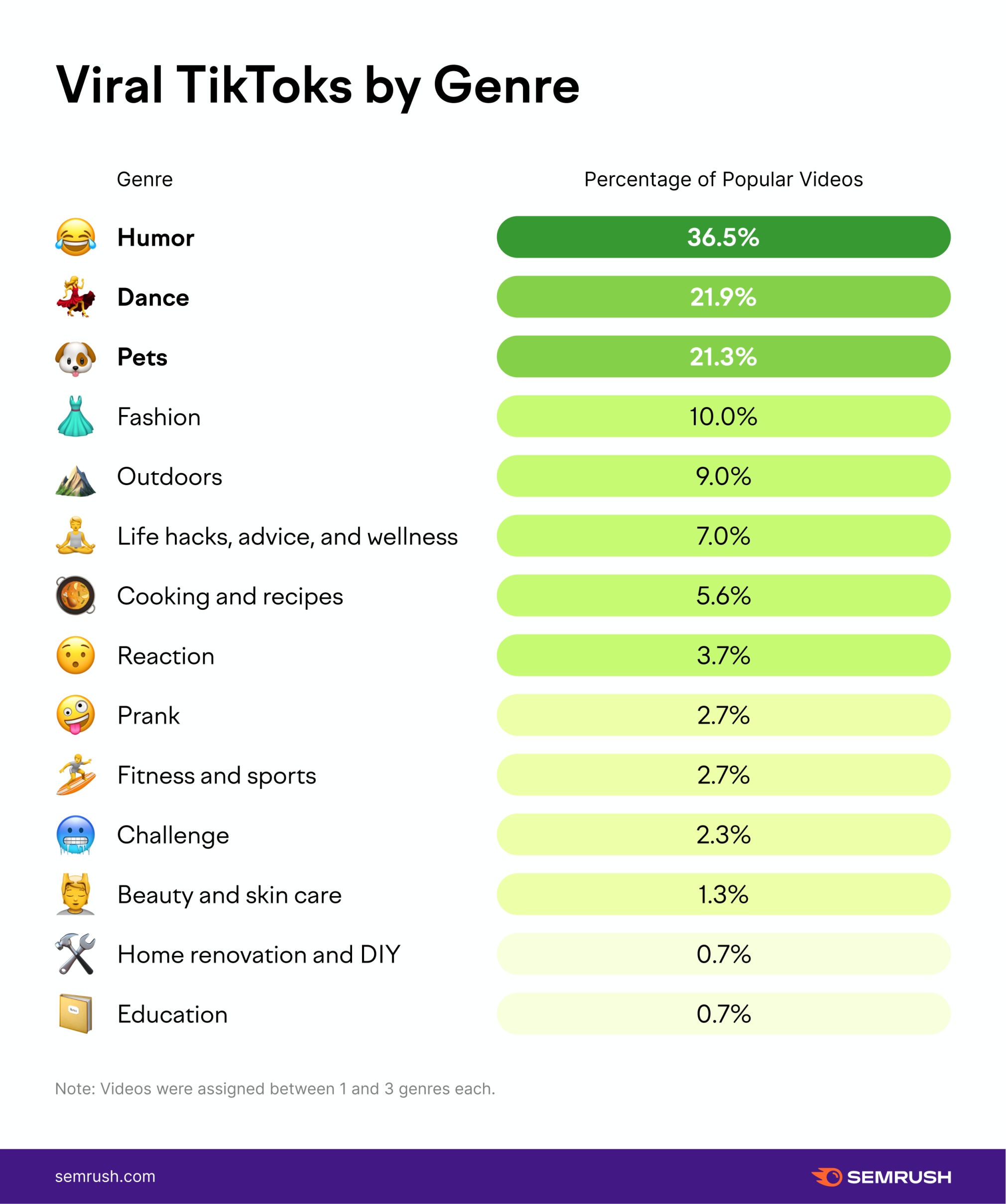
The Sound of Music
There are a lot of catchy tunes available for our listening pleasure these days, and many have been popularized on TikTok. Which genres reign supreme on the app?
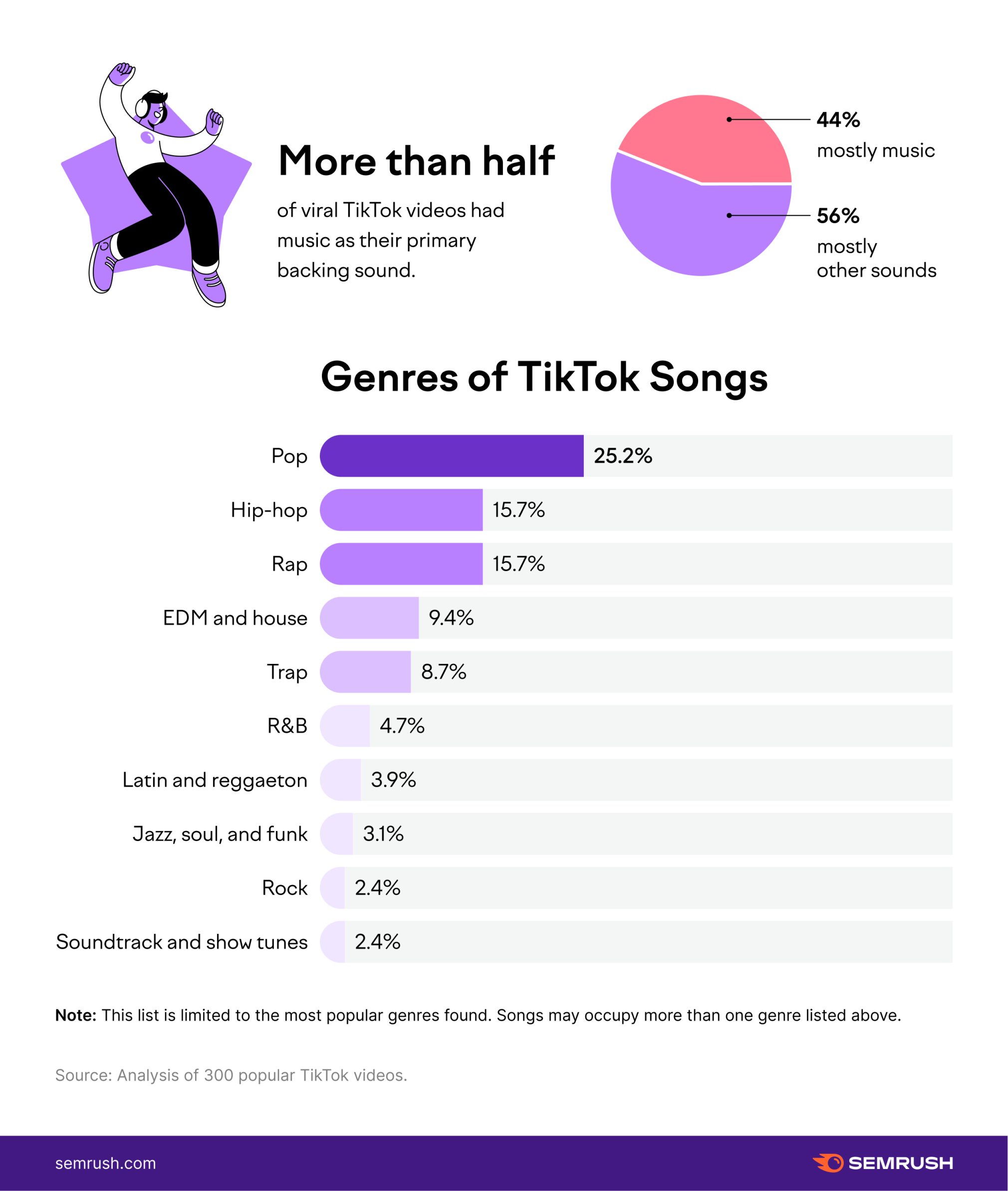
While face-to-face interactions are commonplace in TikTok videos, a conversation isn’t necessarily part of the equation — 56% of viral videos had music as their primary sound. By a large margin, pop songs were heard the most often, followed by hip-hop and rap. Seeing as viral dancing videos had the most plays compared to other kinds of viral videos, it's unsurprising that these music genres were most common.
Videos that featured mostly music as their sound performed better, on average, across all engagement metrics than ones where music was not the focal point of the audio. Only 37% of videos featured truly original sound that was created especially for them, whereas the rest used music or pre-created audio from somewhere else. Interestingly, videos with original sounds performed worse across all engagement metrics.
Error 404: No Shortcuts Found
To fast-track their way toward internet virality, some users tried using keywords in their captions and hashtags like “FYP” (which refers to a user’s curated feed, otherwise known as a ‘For You’ page), “trending,” and “viral.” Around 38% of the TikToks that were analyzed in this study included these keywords.
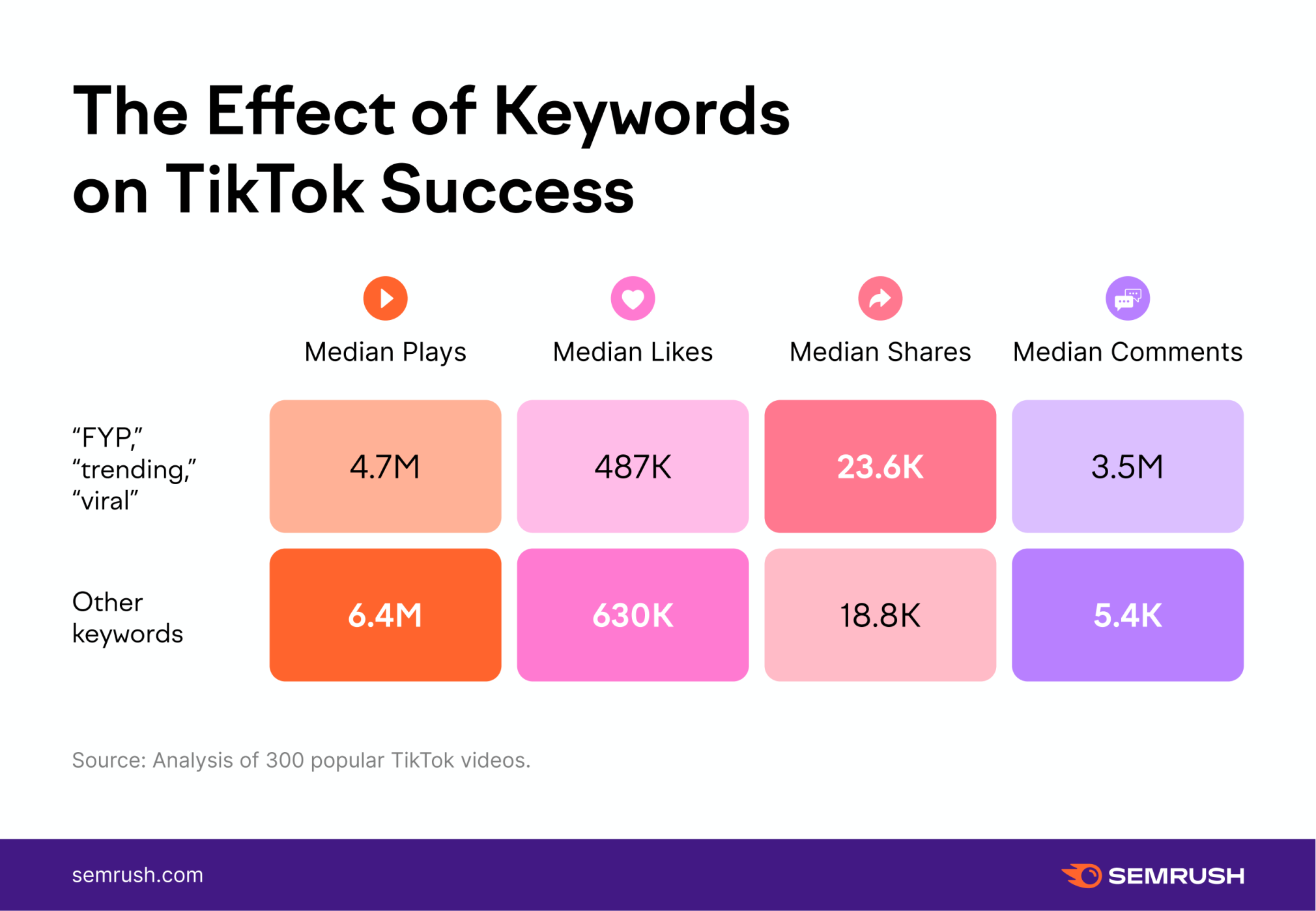
However, compared to other videos with other keywords, ones specifically using variations on “FYP,” “trending,” and “viral” underperformed on all engagement metrics (except for shares). Knowing your audience and using specific, targeted keywords is probably a better strategy than throwing around broad, unfocused terminology.
Lastly, among these popular TikTok videos, caption sentiment (as calculated by a natural language processing algorithm) was positive more than twice as often as it was negative. Among videos with calculable sentiment, 68% were positive, and 32% were negative.
What Does It All Mean?
Our analysis of viral TikTok videos has indicated that doing the following while creating content on the platform could increase your chances of publishing popular videos:
- Regularly include content that speaks directly to your audience, engaging them in a conversation.
- Create videos that will make viewers feel happy and will trigger positive emotions.
- If you’re not a verified creator on TikTok, try creating content directly related to your niche hobbies and interests, such as cooking, dance, pets, or fashion.
If you’re interested in discovering and analyzing the types of content people love to engage with, you’ve come to the right place. Check Semrush’s solutions on Content Marketing and Social Media for more studies, insights, and information.
Methodology and Limitations
First, we used an unofficial TikTok API to retrieve 500 videos from TikTok’s trending feed. The entire sample of videos was collected at one time. These videos were retrieved without logging into a TikTok account and from an IP address in the western United States. To the best of our knowledge, this allowed us to bypass personalization algorithms that could skew our sample.
Then, we used a handful of text and audio processing libraries:
- We made use of the ftfy text encoding fixer by Robyn Speer to repair encoding errors due to processing multiple different text encodings.
- To extract keywords from caption text, we used the YAKE! keyword extractor.
- We used NLTK’s VADER sentiment analyzer to capture sentiment scores for video captions.
- To recognize and classify musical material in the sounds of these videos, we used the AI-powered audio recognition service offered by AudD, LLC.
- Genre information for recognized songs came from the API-accessible metadata for their associated artists as described by Spotify.
After extracting the videos and their metadata, we clipped each video to its first three seconds. Then, a researcher reviewed a sample of 300 clips — the first three hundred of our total sample — and recorded data on 19 characteristics for each video. The fields we ended up using in this analysis were:
- Number of people visible on screen
- Whether someone was speaking
- Who or what they were speaking to
- Whether animals were present on screen
- Types of animals present, if applicable
- Whether the sound in the video was original
- Whether the sound in the video was mostly music or mostly not music
- Most likely intended emotional impression
- Video genre(s)
Factors used in the analysis, which we obtained from metadata directly from TikTok:
- Plays
- Likes
- Shares
- Comments
- Captions
- Hashtags
- Whether the video came from a verified account
The sample sizes for the top 5 video genres as seen in the chart titled “Impact of Genre on Engagement Metrics” are as follows:
- Humor: 110 videos, 37% of sample
- Dance: 66 videos, 22% of sample
- Pets: 64 videos, 21% of sample
- Fashion: 30 videos, 10% of sample
- Outdoors: 27 videos, 9% of sample
This is not a representative study of successful TikTok content. One of the limitations of this study is the use of subjective classification of genre and the intended emotional impact of videos, which may be impacted by the researcher’s unique background. Songs not recognized by the recognition algorithm or that are not present in the Spotify database may have been excluded from analysis.
In-depth analysis of user-created content on social media sites is limited first and foremost by the ephemeral nature of social media trends. We sought to investigate variables that may remain relatively consistent over time, but readers should be aware that trends may change at a rapid pace.
